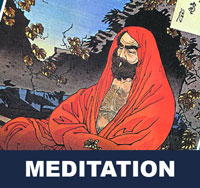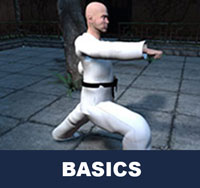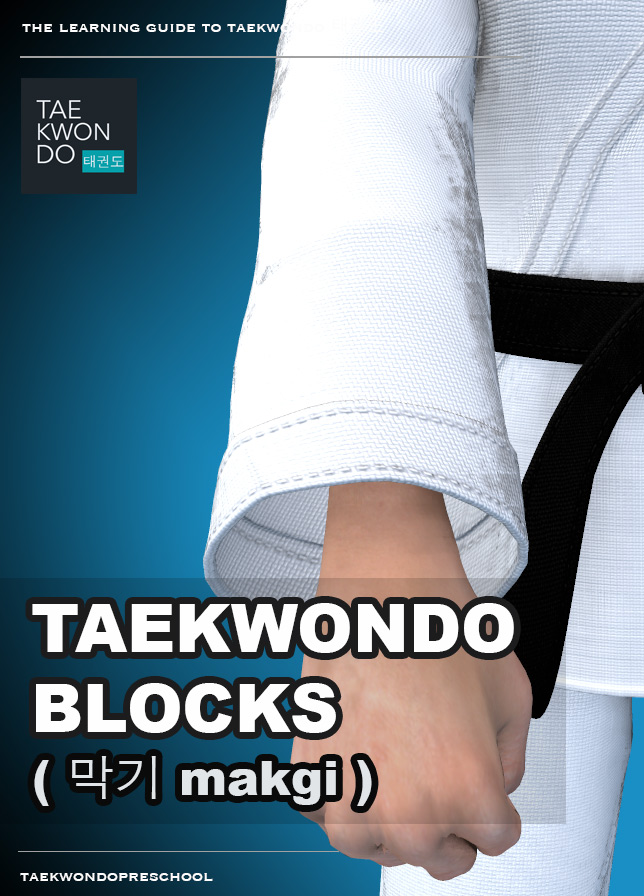Taekwondo 태권도Taekwondo Preschool
Promotion from one geup to the next can proceed rapidly in some schools, since schools often allow geup promotions every two, three, or four months. Students of geup rank learn the most basic techniques first, and then move on to more advanced techniques as they approach first dan. Many of the older and more traditional schools often take longer to allow students to test for higher ranks than newer, more contemporary schools, as they may not have the required testing intervals. View Taekwondo belt levels »

About Qigong
The term meditation refers to a broad variety of practices (much like the term sports) that includes techniques designed to promote relaxation, build internal energy or life force (qi, ki, prana, etc.) and develop compassion, love, patience, generosity and forgiveness.
Qigong is a practice of aligning body, breath, and mind for health, meditation, and martial arts training. With roots in Chinese medicine, philosophy, and martial arts, qigong is traditionally viewed as a practice to cultivate and balance qi (chi) or what has been translated as "life energy".
According to Daoist, Buddhist, and Confucian philosophy, respectively, qigong allows access to higher realms of awareness, awakens one's "true nature", and helps develop human potential.
Qigong practice typically involves moving meditation, coordinating slow flowing movement, deep rhythmic breathing, and calm meditative state of mind. Qigong is now practiced throughout China and worldwide for recreation, exercise and relaxation, preventive medicine and self-healing, complementary and alternative medicine, meditation and self-cultivation, and training for martial arts.
Over the centuries, a diverse spectrum of qigong forms developed in different segments of Chinese society. Traditionally, qigong training has been esoteric and secretive, with knowledge passed from adept master to student in lineages that maintain their own unique interpretations and methods. Although the practice of qigong was prohibited during the Cultural Revolution of the 1960s; it was once again allowed after 1976; and disparate approaches were merged and popularized, with emphasis shifted away from traditional philosophy, spiritual attainment, and folklore, and increasingly to health benefits, traditional medicine and martial arts applications, and a scientific perspective. Since a 1999 crackdown, practice of qigong in China has been restricted. Over the same period, interest in qigong has spread, with millions of practitioners worldwide.
Research concerning qigong has been conducted for a wide range of medical conditions, including hypertension, pain, and cancer treatment. Most systematic reviews of clinical trials have not been conclusive, and all have been based on poor quality clinical studies, such that no firm conclusions about the health effects of qigong can be drawn at this stage.
Etymology
Qigong (Pinyin), ch'i kung (Wade-Giles), and chi gung (Yale) are English words for two Chinese characters: qì (氣) and gōng (功).
Qi (or chi) is often translated as life energy, referring to energy circulating through the body; though a more general definition is universal energy, including heat, light, and electromagnetic energy; and definitions often involve breath, air, gas, or relationship between matter, energy, and spirit. Qi is the central underlying principle in traditional Chinese medicine and martial arts. Gong (or kung) is often translated as cultivation or work, and definitions include practice, skill, mastery, merit, achievement, service, result, or accomplishment, and is often used to mean gongfu (kung fu) in the traditional sense of achievement through great effort. The two words are combined to describe systems to cultivate and balance life energy, especially for health.
Although the term qigong (氣功) has been traced back to Daoist literature of the early Tang Dynasty (618-907 AD), the term qigong as currently used was promoted in the late 1940s through the 1950s to refer to a broad range of Chinese self-cultivation exercises, and to emphasize health and scientific approaches, while de-emphasizing spiritual practices, mysticism, and elite lineages.
History and origins
With roots in ancient Chinese culture dating back more than 4,000 years, a wide variety of qigong forms have developed within different segments of Chinese society: in traditional Chinese medicine for preventive and curative functions, in Confucianism to promote longevity and improve moral character, in Taoism and Buddhism as part of meditative practice, and in Chinese martial arts to enhance fighting abilities. Contemporary qigong blends diverse and sometimes disparate traditions, in particular the Daoist meditative practice of "internal alchemy" (Neidan 內丹术), the ancient meditative practices of "circulating qi" (Xing qi 行氣) and "standing meditation" (Zhan zhuang 站桩), and the slow gymnastic breathing exercise of "guiding and pulling" (Dao yin 導引). Traditionally, knowledge about qigong was passed from adept master to student in elite unbroken lineages, typically with secretive and esoteric traditions of training and oral transmission, and with an emphasis on meditative practice by scholars and gymnastic or dynamic practice by the working masses.

Starting in the late 1940s and the 1950s, the mainland Chinese government tried to integrate disparate qigong approaches into one coherent system, with the intention of establishing a firm scientific basis for qigong practice. In 1949, Liu Guizhen established the name "Qigong" to refer to the system of life preserving practices that he and his associates developed based on Dao yin and other philosophical traditions. This attempt is considered by some sinologists as the start of the modern or scientific interpretation of qigong. During the Great Leap Forward (1958–1963) and the Cultural Revolution (1966–1976), qigong, along with other traditional Chinese medicine, was under tight control with limited access among the general public, but was encouraged in state-run rehabilitation centers and spread to universities and hospitals. After the Cultural Revolution, qigong, along with t'ai chi, was popularized as daily morning exercise practiced en masse throughout China.
Popularity of qigong grew rapidly during the Deng and Jiang eras after Mao Zedong's death in 1976 through the 1990s, with estimates of between 60 and 200 million practitioners throughout China. Along with popularity and state sanction came controversy and problems: claims of extraordinary abilities bordering on the supernatural, pseudoscience explanations to build credibility, a mental condition labeled qigong deviation, formation of cults, and exaggeration of claims by masters for personal benefit. In 1985, the state-run "National Qigong Science and Research Organization" was established to regulate the nation's qigong denominations. In 1999, in response to widespread revival of old traditions of spirituality, morality, and mysticism, and perceived challenges to State control, the Chinese government took measures to enforce control of public qigong practice, including shutting down qigong clinics and hospitals, and banning groups such as Zhong Gong and Falun Gong. Since the 1999 crackdown, qigong research and practice have only been officially supported in the context of health and traditional Chinese medicine. The Chinese Health Qigong Association, established in 2000, strictly regulates public qigong practice, with limitation of public gatherings, requirement of state approved training and certification of instructors, and restriction of practice to state-approved forms.
Through the forces of migration of the Chinese diaspora, tourism in China, and globalization, the practice of qigong spread from the Chinese community to the world. Today, millions of people around the world practice qigong and believe in the benefits of qigong to varying degrees. Similar to its historical origin, those interested in qigong come from diverse backgrounds and practice it for different reasons, including for recreation, exercise, relaxation, preventive medicine, self-healing, complementary and alternative medicine, self-cultivation, meditation, spirituality, and martial arts training.
Practices
Qigong comprises a diverse set of practices that coordinate body (調身), breath (調息), and mind (調心) based on Chinese philosophy. Practices include moving and still meditation, massage, chanting, sound meditation, and non-contact treatments, performed in a broad array of body postures. Qigong is commonly classified into two foundational categories: 1) dynamic or active qigong (dong gong), with slow flowing movement; and 2) meditative or passive qigong (jing gong), with still positions and inner movement of the breath. From a therapeutic perspective, qigong can be classified into two systems: 1) internal qigong, which focuses on self-care and self-cultivation, and 2) external qigong, which involves treatment by a therapist who directs or transmits qi. As moving meditation, qigong practice typically coordinates slow stylized movement, deep diaphragmatic breathing, and calm mental focus, with visualization of guiding qi through the body. While implementation details vary, generally qigong forms can be characterized as a mix of four types of practice: dynamic, static, meditative, and activities requiring external aids.
- Dynamic practice
- involves fluid movement, usually carefully choreographed, coordinated with breath and awareness. Examples include the slow stylized movements of T'ai chi ch'uan, Baguazhang, and Xing yi. Other examples include graceful movement that mimics the motion of animals in Five Animals (Wu Qin Xi qigong), White Crane, and Wild Goose (Dayan) Qigong. As a form of gentle exercise, qigong is composed of movements that are typically repeated, strengthening and stretching the body, increasing fluid movement (blood, synovial, and lymph), enhancing balance and proprioception, and improving the awareness of how the body moves through space.
- Static practice
- involves holding postures for sustained periods of time. In some cases this bears resemblance to the practice of Yoga and its continuation in the Buddhist tradition. For example Yiquan, a Chinese martial art derived from xingyiquan, emphasizes static stance training. In another example, the healing form Eight Pieces of Brocade (Baduanjin qigong) is based on a series of static postures.
- Meditative practice
- utilizes breath awareness, visualization, mantra, chanting, sound, and focus on philosophical concepts such as qi circulation, aesthetics, or moral values. In traditional Chinese medicine and Daoist practice, the meditative focus is commonly on cultivating qi in dantian energy centers and balancing qi flow in meridian and other pathways. In various Buddhist traditions, the aim is to still the mind, either through outward focus, for example on a place, or through inward focus on the breath, a mantra, a koan, emptiness, or the idea of the eternal. In the Confucius scholar tradition, meditation is focused on humanity and virtue, with the aim of self-enlightenment.
- Use of external agents
- Many systems of qigong practice include the use of external agents such as ingestion of herbs, massage, physical manipulation, or interaction with other living organisms. For example, specialized food and drinks are used in some medical and Taoist forms, whereas massage and body manipulation are sometimes used in martial arts forms. In some medical systems a qigong master uses non-contact treatment, purportedly guiding qi through his or her own body into the body of another person.
Forms
There are numerous qigong forms. 75 ancient forms that can be found in ancient literature and also 56 common or contemporary form have been described in a qigong compendium. The list is by no means exhaustive. Many contemporary forms were developed by people who had recovered from their illness after qigong practice.
In 2003, the Chinese Health Qigong Association officially recognized four health qigong forms:
- Muscle-Tendon Change Classic (Yì Jīn Jīng 易筋经).
- Five Animals (Wu Qin Xi 五禽戲).
- Six Healing Sounds (Liu Zi Jue 六字訣).
- Eight Pieces of Brocade (Ba Duan Jin 八段錦).
In 2010, the Chinese Health Qigong Association officially recognized five additional health qigong forms:
- Tai Chi Yang Sheng Zhang (太极养生杖): a tai chi form from the stick tradition.
- Shi Er Duan Jin (十二段锦): seated exercises to strengthen the neck, shoulders, waist, and legs.
- Daoyin Yang Sheng Gong Shi Er Fa (导引养生功十二法): 12 routines from Daoyin tradition of guiding and pulling qi.
- Mawangdui Daoyin (马王堆导引术): guiding qi along the meridians with synchronous movement and awareness.
- Da Wu (大舞): choreographed exercises to lubricate joints and guide qi.
Other commonly practiced qigong styles and forms include the following:
- Soaring Crane Qigong
- Wisdom Healing Qigong
- Pan Gu Mystical Qigong
- Wild Goose (Dayan) Qigong
- Dragon and Tiger Qigong
- Primordial Qigong (Wujigong)
Techniques
Whether viewed from the perspective of exercise, health, philosophy, or martial arts training, several main principles emerge concerning the practice of qigong:
- Intentional movement: careful, flowing balanced style
- Rhythmic breathing: slow, deep, coordinated with fluid movement
- Awareness: calm, focused meditative state
- Visualization: of qi flow, philosophical tenets, aesthetics
- Chanting/Sound: use of sound as a focal point
Additional principles:
- Softness: soft gaze, expressionless face
- Solid Stance: firm footing, erect spine
- Relaxation: relaxed muscles, slightly bent joints
- Balance and Counterbalance: motion over the center of gravity
Advanced goals:
- Equanimity: more fluid, more relaxed
- Tranquility: empty mind, high awareness
- Stillness: smaller and smaller movements, eventually to complete stillness
The most advanced practice is generally considered to be with little or no motion.
Meditation and Self Cultivation applications
Qigong is practiced for meditation and self-cultivation as part of various philosophical and spiritual traditions. As meditation, qigong is a means to still the mind and enter a state of consciousness that brings serenity, clarity, and bliss. Many practitioners find qigong, with its gentle focused movement, to be more accessible than seated meditation.
Qigong for self-cultivation can be classified in terms of traditional Chinese philosophy: Daoist, Buddhist, and Confucian.
Martial Arts applications
The practice of qigong is an important component in both internal and external style Chinese martial arts. Focus on qi is considered to be a source of power as well as the foundation of the internal style of martial arts (Neijia). T'ai chi ch'uan, Xing yi, and Baguazhang are representative of the types of Chinese martial arts that rely on the concept of qi as the foundation. Extraordinary feats of martial arts prowess, such as the ability to withstand heavy strikes (Iron Shirt, 鐵衫) and the ability to break hard objects (Iron Palm, 铁掌) are abilities attributed to qigong training.
T'ai chi ch'uan and qigong
T'ai chi ch'uan (Taijiquan) is a widely practiced Chinese internal martial style based on the theory of taiji ("grand ultimate"), closely associated with qigong, and typically involving more complex choreographed movement coordinated with breath, done slowly for health and training, or quickly for self-defense. Many scholars consider t'ai chi ch'uan to be a type of qigong, traced back to an origin in the 17th century. In modern practice, qigong typically focuses more on health and meditation rather than martial applications, and plays an important role in training for t'ai chi ch'uan, in particular used to build strength, develop breath control, and increase vitality ("life energy").

Related Articles
Meditation is a practice in which an individual trains the mind or induces a mode of consciousness. The practice has a calming effect and directs awareness inward until pure awareness is achieved, described as being awake inside without being aware of anything except awareness itself. Meditation is often used to clear the mind and ease many health issues, such as high blood pressure, depression, and anxiety. View Meditation »
- History of Mediation - the history is intimately bound up with the religious context within which it was practiced. Around the 6th to 5th centuries BCE, other forms of meditation developed in Taoist China and Buddhist India.
- Definition of Meditation - refers to practices that includes techniques designed to promote relaxation, build internal energy or life force and develop compassion, love, patience, generosity and forgiveness. A particularly ambitious form of meditation aims at effortlessly sustained single-pointed concentration single-pointed analysis, meant to enable its practitioner to enjoy an indestructible sense of well-being while engaging in any life activity.
- Mediation Postures - various meditative postures have been used in meditation such as sitting cross-legged, sitting on a chair, and standing postures. In taekwondo, one can meditate in several stances ( 서기 sogi ) including the Back Stance ( 뒷굽이 dwi-kubi ) and the Crane Stance ( 학다리서기 hakdari-sogi ). One should feel comfortable and rest in a simple and unstrained way.
- Qigong - practice of aligning body, breath, and mind for health, meditation, and martial arts training. With roots in Chinese medicine, philosophy, and martial arts, qigong is traditionally viewed as a practice to cultivate and balance Qi (chi) or what has been translated as life energy.

Taekwondo Basics
Here is where you can learn more about Taekwondo 태권도. Knowing the fundamental basics is very important for your learning path as you build your skills and knowledge. There are certain rules that need to be followed to show respect to the master ( 사범님 sabeomnim ), the instructors ( 교사님 gyosannim ), other practitioners and to the martial arts. They vary between schools but many have similar rules and guidelines. For more information View Taekwondo Basics »
There are five tenets defined in the International Taekwondo Federation (ITF) and several more in World Taekwondo (WT).
Perseverance ( 인내 in-nae ): "One will persevere time and time again until they have achieved a result which is adequate towards what one was trying to achieve." View Taekwondo Tenets »
RESOURCES
This article uses material from the Wikipedia article "Meditation", which is released under the Creative Commons Attribution-Share-Alike License 3.0.









